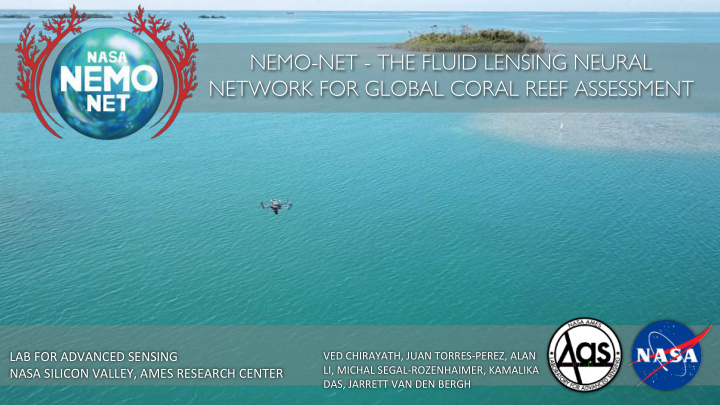



NEMO-NET - THE FLUID LENSING NEURAL NETWORK FOR GLOBAL CORAL REEF ASSESSMENT LAB FOR ADVANCED SENSING VED CHIRAYATH, JUAN TORRES-PEREZ, ALAN LI, MICHAL SEGAL-ROZENHAIMER, KAMALIKA NASA SILICON VALLEY, AMES RESEARCH CENTER DAS, JARRETT VAN DEN BERGH
NEMO-NET TEAM EXPANSION 2
NEMO-NET TEAM PI: DR. VED CHIRAYATH SCIENCE DR. JUAN TORRES-PEREZ, DR. SAM PURKIS M/L DR. ALAN LI, DR. MICHAL SEGAL-ROZENHAINMER, DR. KAMALIKA DAS GAME JARRETT VAN DEN BERGH, JOEY SCHUTZ, SIMON BENICHOU, YUVIKA DUBE, FERNANDO ZAMORA, ALYSSA DE LA TORRE 3
NEMO-NET SCIENTIFIC OBJECTIVES 1) Develop the most accurate algorithm for identification of coral organisms from remote sensing at different scales. 2) Globally assess the present and past dynamics of coral reef systems through a large-scale active learning neural network. 3) Quantify coral reef percent cover and spatial distribution at finest possible spatial scale. 4) Characterize benthic habitats into 24 global hierarchical classes, resolving coral families with fluid lensing at finest scales. 4
NEMO-NET TECH DEVELOPMENTS 1) Developed malleable CNN architecture for scalable heterogenous computing architecture. 2) Created cloud masking CNN algorithm. 3) Implemented domain transfer learning for spectral and spatial resolution transfer learning (super resolution) across multiple sensors. 4) Created 3D active learning CNN training application in game interface for data training from multiple sensors. 5
OCEAN WAVE FLUID LENSING PHENOMENON Caustics Fluid lenslets and evolution of caustics
2D Fluid Lensing, Coral Test Target, Depth = 4.5m, MSL No Fluid Raw Distorted Frames 2D Fluid Lensing Results Mean Image 2D Fluid Lensing Integration Flat Fluid
NEMO-NET DATA SOURCES Sensor Effective Spatial Resolution 3D Spectral Bands Locations Australia, Great Barrier Reef, Underwater AUV 0.1 - 5 cm YES 3 Pacific American Samoa, Guam, Western FluidCam & MiDAR (NASA) 0.1 ~ 2 cm cm YES 3-8 Australia, Puerto Rico, Indo- Pacfifc QuickBird (USGS) 0.65 m NO 4 US Territories WorldView-2/3 (LOF) 0.5 - 3 m NO 8 Global Hawaii, Mariana Islands, Palau, CORAL PRISM (NASA) 7 m NO 248 Guam, Great Barrier Reef Landsat (USGS) 30 m NO 11 Global FluidCam QuickBird WorldView-2 PRISM
1. Best Remote Sensing Image 2. Fluid Lensing on UAV 5. Underwater Photogrammetry 3. Fluid Lensing Detail 4. FL + SFM Depth 80 cm 80 cm 103m 3.5m 3.5m 20 cm 30m 1.3m -3m 1.8m 9 30m 30m MSL
ACTIVE LEARNING FRAMEWORK User Classified Data Prepared Data Data Preparation Training Image • Fill in gaps in user Match with Data classified data (most satellite data common neighbor) • Data normalization Training Label • Label conversion Data • Data randomization and augmentation • Export image blocks Validation to appropriate folders Image Data • Export segmentation truth map Validation Label Data To CNN 10
NEMO-NET PROTOTYPE DATA PRODUCTS
NeMO-Net Ingestion of Multi-Modal MM-Scale Airborne MM-Scale Airborne M-Scale Airborne Fluid Lensing Fluid Lensing DEM & Satellite Data Data, Data Fusion, & Training VR & App-based Active Learning & Interactive Training through IUCN, Mission Blue, & Partners NeMO-Net Living Structure & Morphology Classification Science Partners Level 1 Data & Existing Training Data Analysis Active Learning Training of Coral Cover & Morphology Type
NEMO-NET CLASSIFICATION HIERARCHY Level 1 Level 2 Level 3 Level 4 Level 5 Level 6 Zone Major Detailed Geomorphological Structure Biological Cover Biological Morphology Taxonomy Geomorphological Structure Reef Crest Coral Reef and Hardbottom Reef Crest/Coralline Algae Ridge Live Coral Branching Coral Acroporidae Fore-Reef Fore-Reef Deep Slope Algae Massive Coral Agariciidae Reef Flat Fore-Reef Shallow Slope Higher Plants Octocorals Astrocoeniidae Back-Reef Fore-Reef Shallow Terrace Prokaryotes Macroalgae Merulinidae Lagoon Fore-Reef Octocorals-dominated (Caribbean) No Cover Turf Algae Montastraeidae Bank/Shelf Back-Reef Pavement Unknown Coralline Algae Mussidae (Faviidae) Escarpment Back-Reef Coral Framework Seagrasses Poritidae Channel Back-Reef Coral Bommies Mangroves Siderastreidae Dredged Back-Reef Octocorals-dominated (Caribbean) Cyanobacteria Meandrinidae Lagoon Lagoon Pinnacle Reefs Unknown Pocilloporidae Shoreline Intertidal Lagoon Patch Reefs Pectinidae Salt Pond Lagoon Fringing Reefs Fungiidae Inland Water Lagoon Deep water Caryophyliidae Land Unconsolidated Sediment Fore-Reef Sand Flats Dendrophyliidae Unknown Back-Reef Sediment-dominated Gorgoniidae Lagoon Sediment Apron/Barren Plexauridae Other Deep Ocean Water Alcyoniidae Seagrass Meadows Nephtheidae Intertidal Wetlands Phylum Chlorophyta Beach (Sand) Phylum Phaeophyta Beach (Rock/Dark) Phylum Rhodophyta Terrestrial Mangroves Angiospermae Terrestrial Vegetated Phylum Cyanophyta No Data/ Clouds/Unknown Unknown 13
These will be modified to In-game field guide L6 Classes • Each class label will contain photos of typical species/genera • May vary depending on the geographical location of These will be modified to the image to be processed L6 Classes (e.g., Atlantic/Caribbean vs Indo-Pacific) 14
UPCOMING NASA NEMO-NET APP - 2019 15
NEMO-NET NEWS PUERTO RICO FIELD CAMPAIGN! 16
Puerto Rico Field Mission • March 6-18, 2019 • Concentrated on the southwest coast (La Parguera Natural Marine Reserve) • 3 reef sites (legacy sites for previous NASA campaigns: 2004-2009; HICE-PR; CoralBASICS) • Coordination with the University of PR – Department of Marine Sciences – Bio-optical Oceanography Laboratory (Dr. Roy Armstrong, Director) • Collection of high resolution camera data for NeMO- Net 17
18
• Actually… 10x10m phototransects • ~80% overlapping between photos • > 5 phototransects per reef site • Capture uniform and mixed areas
20
PR mission (March 8-17, 2019) – La Parguera (Southwest, PR)
Typical waypoint sampling - video • ~ 500-800 waypoints per reef • ~ 1GB of data per waypoint • ~ 2.3 cm spatial resolution
PUBLICATIONS AND NEXT STEPS … 1) Accepted, 2019. Remote Sensing of Environment. Fluid Lensing and Machine Learning for Automated Centimeter- Resolution Airborne Assessment of Coral Reefs in American Samoa without Ocean Wave Distortion. 2) In review, 2019. Cloud Detection Algorithm for Multi-Modal Satellite Imagery using Convolutional Neural-Networks (CNN). 3) In review, 2019. Special Issue, Frontiers in Marine Science.Next-Generation Optical Sensing Technologies for Exploring Ocean Worlds - NASA FluidCam, MiDAR, and NeMO-Net. 4) Guam Field campaign – May 2019 (last week!) Palau Field Campaign – Sept 2019 before the 42 nd US Coral 5) Reef Task Force meeting 6) Several other publications under development 23
Thank you!
Recommend
More recommend